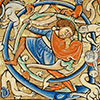Drawn up in the 1140s these were the prime authority for the Papal Decretals and hence Canon Law at the time of the Constitutions of Clarendon and the consequent Becket Controversy.
The clauses which define Clerical Immunity, the Privilegium Fori (the Benefit of Clergy)
Causa XI. Qaestio I. Capitula I
Apud Secularem iudicem nullus clericus conveniatur.
(No cleric to appear before a secular judge)
Causa XI. Qaestio I. Capitula IX.
Quilibet clericus non est in publicus examinandus.
(No cleric is to be examined in public)
Causa XI. Qaestio I. Capitula XIII.
Non nisi ad episcoporum iudicium clericus devocetur.
(A cleric may only be summoned for judgment before his bishop)
Causa XI. Qaestio I. Capitula XIV.
Ante civilem iudicem sacerdotes non accusentur.
(Priests may not be arraigned before civil justices)
Causa XI. Qaestio I. Capitula XXXIII.
Nullus clericus propter aliquam causam intret curiam.
(No cleric may go near a [civil] court on any case [concerning him].)
Causa XI. Qaestio I. Capitula XXXVIII.
Presbiter apud episcopum tantum iudicari debet.
(A priest should only be judged by his bishop)
Causa XI. Qaestio I. Capitula XLI.
Sacerdotes a regibus sunt honorandi, non iudicandi.
(Priests are to be honoured by kings, not to be judged [by them].)
Causa XI. Qaestio I. Capitula XLIV.
Clericus non accusetur, nisi ante ecclesiasticum iudicem.
(A cleric may be charged [with a crime], but only brought before ecclesiastical justice.)
These clauses clearly state that Becket was entirely within his rights to stand his ground. The Decretum Gratiani unambiguously state that clerics were not to be brought before civil or secular courts, but referred to their bishops for justice.
Becket was wholly within his rights as a priest to demand an appeal to or refer to the Pope in any case where there was any ambiguity regarding these principles, including in his own cause for the case that was being pursued against him at the Council of Northampton, October 1164. The clauses in the Constitutions of Clarendon are in clear conflict with the Canonical Law of the time. The Canonical Law was absolutely unequivocal on this: clerics were not to be tried in secular courts, or by secular justice.
Extracts from
Munich Digital Library
http://www.muenchener-digitalisierungszentrum.de/
Decretum Gratiani (Kirchenrechtssammlung)
CAUSA XI.
GRATIANUS.
Clericus aduersus clericum questionem de prediis agitauit,
quem ad ciuilem iudicem producere uoluit reus non nisi ante
iudicem ecclesiasticum stare uolebat; actor uero potentia ciuilis
iudicis illum a possessione sua deiecit. Quo audito episcopus eum
ab offitio suspendit; ille contempta episcopi sui sententia offitium
suum administrauit. Hoc conperto episcopus sine spe
restitutionis in eum sententiam dedit. (Qu. I.) Hic primum
queritur, utrum clericus ante ciuilem iudicem sit producendus?
(Qu. II.) Secundo, si producendus non est, an hec culpa sit
digna suspensione? (Qu. III.) Tertio, si digna non fuerit, an contemptorem
sententiae sui episcopi inreparabiliter oporteat deponi?
Chapters:
References
Patrologia Latina - Volume 200
Decretum Gratiani Pub: Frobenius (Basle 1512)
Patrologiae cursus completus [Series Latina, Volume 187]
Decretum Gratiani
Compiled by Jacques-Paul Migne
(Paris 1861)
(Paris 1891)
pp. 818-38.

No comments:
Post a Comment
Note: only a member of this blog may post a comment.